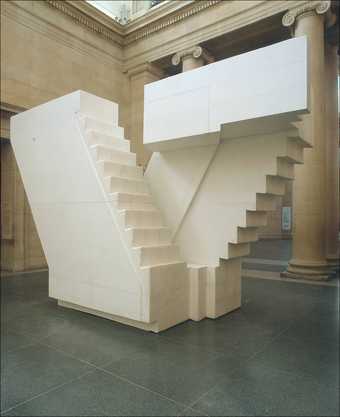4 rooms in Art Around the Building
We are invited to look at, listen to, smell and read the artworks in this display. Five different artists encourage us to become participants in the artwork
These Tate collection works use diverse materials to reveal and memorialise the temporary or intangible: journeys, lives lived, and the links between people and parts of the world.
Vong Phaophanit’s Neon Rice Field contains white rice and neon lights. When combined they create the optical illusion of an undulating paddy field. For the artist, this ‘third material’ symbolises the idea of cultural identity as unfixed and imaginary.
For Untitled (Staircase), Rachel Whiteread cast in plaster the inside of a building that had been a church, a synagogue and a factory.
The artwork makes solid the memories that were associated with this space.
In Lydia Ourahmane’s The Third Choir, twenty echoing oil barrels stand in place of Algerian migrants, having taken the same route across the Mediterranean Sea to Europe.
Monument by Susan Hiller replicates Victorian memorial plaques from Postman’s Park, near St Paul’s Cathedral, London. The plaques commemorate people who died while saving the lives of others. The work’s accompanying sound piece reflects on the representation of life after death.
At the north end of the gallery, Anya Gallaccio’s preserve ‘beauty’ sees 2,000 gerbera flowers in bloom, wilt, die and decay – the cycle of life, contained between two panes of glass.
Art in this room




Sorry, no image available

